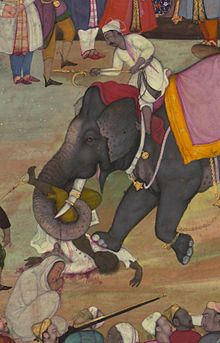
Back الإعدام بالفيلة Arabic Aplastamientu por elefante AST Fil ilə edam Azerbaijani Стъпкване от слон Bulgarian Gnječenje slonom BS Execució mitjançant l'ús d'un elefant Catalan Henrettelse med elefant Danish Exekution durch Elefanten German Ekzekuto per elefanto Esperanto Aplastamiento por elefante Spanish

Execution by elephant, or Gunga Rao, was a method of capital punishment in South and Southeast Asia, particularly in India, where Asian elephants were used to crush, dismember, or torture captives during public executions. The animals were trained to kill victims immediately or to torture them slowly over a prolonged period. Most commonly employed by royalty, the elephants were used to signify both the ruler's power of life and death over his subjects and his ability to control wild animals.[1]
The sight of elephants executing captives was recorded in contemporary journals and accounts of life in Asia by European travellers. The practice was eventually suppressed by the European colonial powers that colonised the region in the 18th and 19th centuries. While primarily confined to Asia, the practice was occasionally used by European and African powers, such as Ancient Rome and Ancient Carthage, particularly to deal with mutinous soldiers.
© MMXXIII Rich X Search. We shall prevail. All rights reserved. Rich X Search